By Molly Brown, Wetlands Placement Student
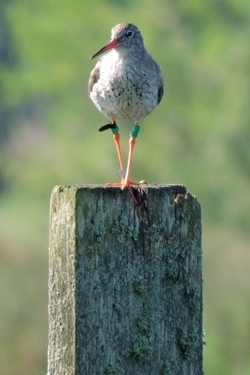 The Avon Valley is a linear water meadow system, which remains a stronghold for breeding redshank. In 2015, there were 19 pairs of breeding redshank, which had increased to 35 pairs by 2019. This was documented by extensive monitoring during the LIFE Waders for Real project, and Wetlands Ecologist Lizzie Grayshon continues to monitor the breeding waders of the Avon Valley. Across the UK, redshank breeding pairs and breeding success has been steeply declining since around 2000. To have a population of breeding redshank in the Avon Valley that is increasing highlights the potential benefit of targeted management and suggests there is a chance to reduce the decline of redshank elsewhere in the UK.
The Avon Valley is a linear water meadow system, which remains a stronghold for breeding redshank. In 2015, there were 19 pairs of breeding redshank, which had increased to 35 pairs by 2019. This was documented by extensive monitoring during the LIFE Waders for Real project, and Wetlands Ecologist Lizzie Grayshon continues to monitor the breeding waders of the Avon Valley. Across the UK, redshank breeding pairs and breeding success has been steeply declining since around 2000. To have a population of breeding redshank in the Avon Valley that is increasing highlights the potential benefit of targeted management and suggests there is a chance to reduce the decline of redshank elsewhere in the UK.
The GWCT Wetlands department is studying the breeding ecology of redshank in the valley and are aiming to discover more about this fascinating bird’s breeding behaviour and ecology. We need a better knowledge of redshank territory size and how faithful birds are to their breeding sites within a breeding season and between seasons. We also need to know about the movement of birds in the valley – where they feed and where they go to in winter. This information allows us to refine management recommendations designed to benefit redshank, by understanding the specific habitats that are most important for nest and chick-rearing, and the areas of habitat required by each pair.
Ringing involves fitting a bird with a lightweight, uniquely numbered metal ring, which enables identification of that individual when recaptured by another ringer or found dead by a member of the public. Bird ringing can provide data on a species’ survival and movements but depends upon these subsequent re-encounters, so many individuals have to be rung to provide robust data. Recapturing ringed birds usually requires a lot of effort.
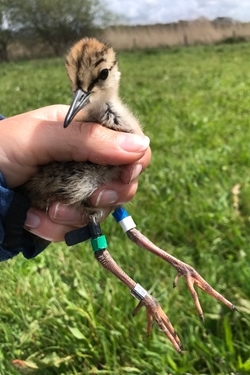 Colour ringing involves fitting a unique combination of coloured rings to a bird’s leg. This enables identification of an individual bird in the field, without the need to recapture the bird to read the metal ring number. Larger, long-lived species like waders and gulls are particularly suited to colour ringing because the bird and its rings are more visible and may be reported multiple times during the bird’s life. Ringing of all kinds is only performed under strict licence, and colour-ringing projects must obtain approval from a central co-ordinator that considers both bird welfare and the viability of the study.
Colour ringing involves fitting a unique combination of coloured rings to a bird’s leg. This enables identification of an individual bird in the field, without the need to recapture the bird to read the metal ring number. Larger, long-lived species like waders and gulls are particularly suited to colour ringing because the bird and its rings are more visible and may be reported multiple times during the bird’s life. Ringing of all kinds is only performed under strict licence, and colour-ringing projects must obtain approval from a central co-ordinator that considers both bird welfare and the viability of the study.
Colour ringing redshank in the Avon Valley has required a huge amount of dedication during the breeding season. First, the territories are mapped and the number of pairs are recorded. Then, the nest needs to be found and mapped, establishing when eggs were laid to enable an accurate estimation of hatch date (anywhere from early April to late June). Once the chicks have hatched, there is limited time to catch and ring them before they fledge. The monitoring of breeding adults is done with minimal disturbance to them, using binoculars and a telescope, with only a small number of carefully timed visits to measure the eggs and ring the chicks.
In 2021, Lizzie successfully colour ringed 12 redshank – four adults and eight chicks. All of these colour-ringed individuals have been resighted, nine of them outside of the Avon Valley. This is an unusually high resighting rate!
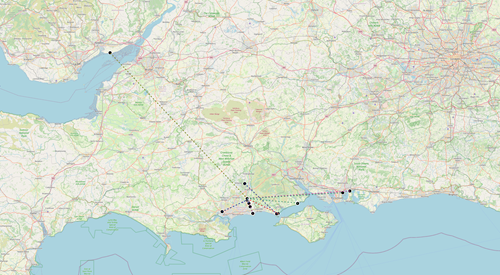
One particular brood highlights the interesting results that colour ringing can produce. Lizzie colour ringed an adult female and her four chicks in late April. The adult female has been resighted five times, mostly at Stanpit Marsh near the mouth of the River Avon, and one of her the fledged chicks was also spotted there. Two of the other fledged chicks were resighted at nearby sites in Hampshire: Langstone, near Chichester Harbour; and Keyhaven, at the Fishtail Lagoon and the Pans Wetlands.
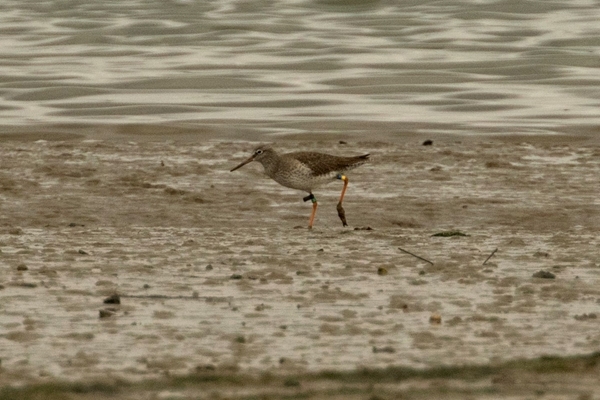
Photo taken by Nigel Jones at Needs Ore at Beaulieu NNR of a juvenile
redshank, colour ringed in the Avon Valley when it was a chick.
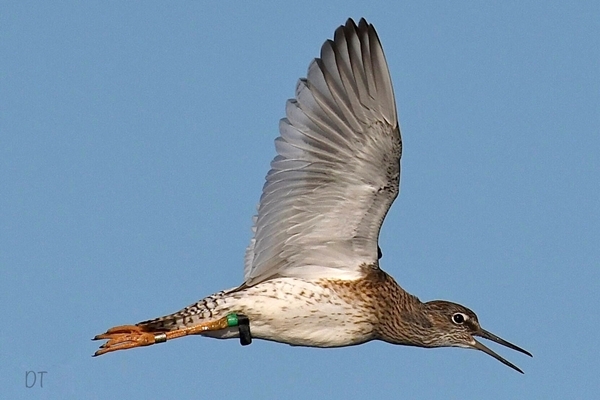 Photo by Dave Taylor
Photo by Dave Taylor
In contrast, the fourth chick has been resighted over 100km away at the Gwent Levels Wetland Reserve in Newport, Wales.
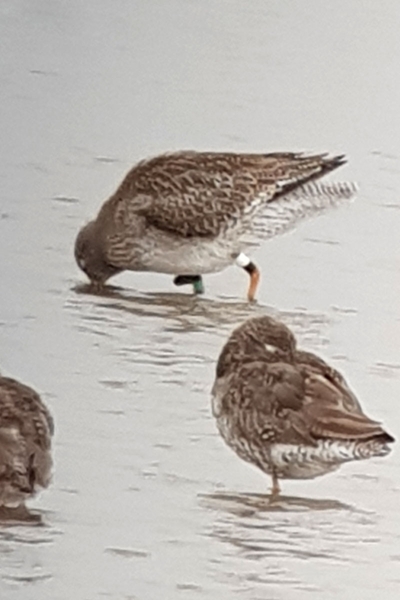 Photo taken by Chris Jones in Newport, Wales of a juvenile redshank,
Photo taken by Chris Jones in Newport, Wales of a juvenile redshank,
colour ringed in the Avon Valley when it was a chick.
By colour ringing just a small number of redshank in 2021, we have learnt a huge amount about their movements post-fledging and breeding. Hopefully in a few months we will see some of our colour-ringed individuals returning to the Avon Valley.
The success of redshank breeding in the valley really reflects the effort of the farmers and gamekeepers who have made positive changes to create habitat for breeding waders. Hopefully this coming spring will prove to be another successful breeding season, and we will be able to colour ring more redshank chicks and adults and add to our growing dataset.
Reporting colour-ringed birds is absolutely essential for this project to work, and we are incredibly grateful to everyone who has reported ringed birds or submitted photographs. If you see a colour-ringed bird, please record where you are, the bird species, and the colour ring sequence above and below the ‘knee’ on each leg, including the position of the metal BTO ring if possible. Birds that have been colour ringed anywhere in Europe can be reported on this website.